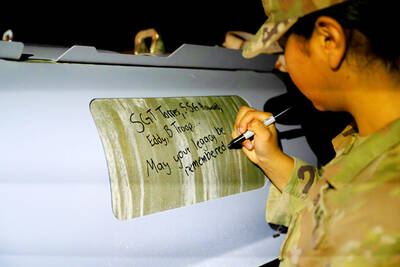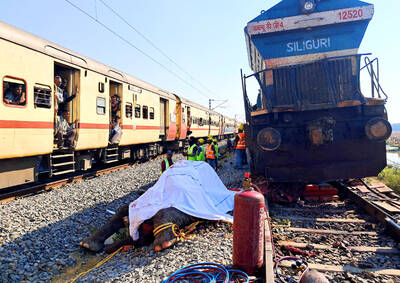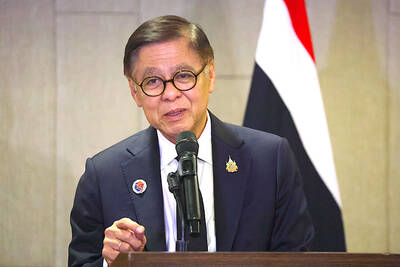A spate of violent attacks on Indians in Australia is straining bilateral relations and costing Australian universities lucrative foreign student revenue. There is sharp debate, however, about whether racism is at the root of the problem.
Some Indian officials and media have been quick to blame racism for the highly publicized beatings, robberies and murders, mostly in Melbourne, Australia’s second largest city and one proud of its cultural diversity. India has demanded swift action to protect its citizens.
Australia, which regards itself as a multicultural success story, has staunchly defended its reputation for welcoming foreigners — including students whose tuition fees are worth A$12 billion (US$11 billion) a year to a burgeoning export industry in education.
Discerning the truth, amid the back and forth, has proven difficult.
The controversy comes amid explosive growth in the foreign student population in Australia. The Indians have grown the fastest, from 2,700 in 2002 to 91,400 last year. Overall, foreign students rose from 150,000 to almost 400,000 during the same period.
Australian universities expect Indian enrollment to plummet 30 percent this year, in part because of safety fears.
No doubt there is racism in Australia, as in virtually every society. Researchers have found that one in 10 adults here could be described as racist, a proportion that is not negligible, University of Western Sydney geographer Kevin Dunn said.
“It’s good that they’re a minority of people, but what’s bad is if we deny that that’s out there, and secondly, that we don’t do anything about it,” he said. “My concern is the Indians are right in saying that on those latter two points, we’ve got a problem.”
To what degree racism is behind the attacks is another question.
Melbourne-based Monash University social scientist Andrew Markus, whose own research supports Dunn’s findings, said factors other than anti-Indian sentiment also put the students at risk.
For example, they often stay in inexpensive housing in crime-ridden neighborhoods and work night shifts driving taxis or staffing takeout food restaurants, he said.
Pino Migliorino, chairman of the Federation of Ethnic Communities’ Councils of Australia, agreed the government should do more to combat racism.
But he is not convinced that the violence against Indians is racially motivated, or that Indians face more racism than other groups.
Indian students are a particularly articulate group with access to established Indian media in Melbourne and an ability to attract international attention, he said.
“A group of Sudanese kids might be harassing, they might be harassed, they might have been in a fight, but whether that develops into a major incident which has repercussions internationally, I would doubt it,” Migliorino said.
Gautam Gupta, a spokesman for the Federation of Indian Students of Australia, said foreign students who do not come from democratic societies are reluctant to stand up for their rights.
“Indians are used to freedom of speech, we are used to raising our voices to get things done,” said Gupta, whose group led street marches in Melbourne last year against racial violence.
Gupta said that Indian students have been campaigning against violence for eight years. However, the issue gathered steam following the near-fatal stabbing of an Indian student at a party in Melbourne in September and the stabbing death of a 21-year-old Indian graduate last month, also in Melbourne.
The Australian government and police have played down the racism angle, saying there is no hard evidence that Indians are being disproportionately targeted.
This week, Victoria state Premier John Brumby accused Indian media and some government representatives of lacking objectivity.
He spoke after police charged an Indian man who had claimed he was attacked in Melbourne with faking the story to back a false insurance claim, and suspects in the murder of another Indian man were revealed to be Indian themselves.
“I hope that there is some balance to the debate, some balance to the reporting in India and certainly to date that balance hasn’t been there,” Brumby said.

REVENGE: Trump said he had the support of the Syrian government for the strikes, which took place in response to an Islamic State attack on US soldiers last week The US launched large-scale airstrikes on more than 70 targets across Syria, the Pentagon said on Friday, fulfilling US President Donald Trump’s vow to strike back after the killing of two US soldiers. “This is not the beginning of a war — it is a declaration of vengeance,” US Secretary of Defense Pete Hegseth wrote on social media. “Today, we hunted and we killed our enemies. Lots of them. And we will continue.” The US Central Command said that fighter jets, attack helicopters and artillery targeted ISIS infrastructure and weapon sites. “All terrorists who are evil enough to attack Americans are hereby warned

Seven wild Asiatic elephants were killed and a calf was injured when a high-speed passenger train collided with a herd crossing the tracks in India’s northeastern state of Assam early yesterday, local authorities said. The train driver spotted the herd of about 100 elephants and used the emergency brakes, but the train still hit some of the animals, Indian Railways spokesman Kapinjal Kishore Sharma told reporters. Five train coaches and the engine derailed following the impact, but there were no human casualties, Sharma said. Veterinarians carried out autopsies on the dead elephants, which were to be buried later in the day. The accident site

‘POLITICAL LOYALTY’: The move breaks with decades of precedent among US administrations, which have tended to leave career ambassadors in their posts US President Donald Trump’s administration has ordered dozens of US ambassadors to step down, people familiar with the matter said, a precedent-breaking recall that would leave embassies abroad without US Senate-confirmed leadership. The envoys, career diplomats who were almost all named to their jobs under former US president Joe Biden, were told over the phone in the past few days they needed to depart in the next few weeks, the people said. They would not be fired, but finding new roles would be a challenge given that many are far along in their careers and opportunities for senior diplomats can

RUSHED: The US pushed for the October deal to be ready for a ceremony with Trump, but sometimes it takes time to create an agreement that can hold, a Thai official said Defense officials from Thailand and Cambodia are to meet tomorrow to discuss the possibility of resuming a ceasefire between the two countries, Thailand’s top diplomat said yesterday, as border fighting entered a third week. A ceasefire agreement in October was rushed to ensure it could be witnessed by US President Donald Trump and lacked sufficient details to ensure the deal to end the armed conflict would hold, Thai Minister of Foreign Affairs Sihasak Phuangketkeow said after an ASEAN foreign ministers’ meeting in Kuala Lumpur. The two countries agreed to hold talks using their General Border Committee, an established bilateral mechanism, with Thailand